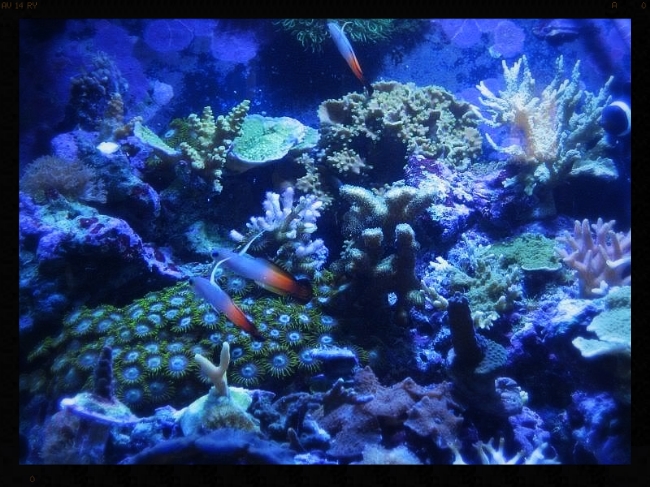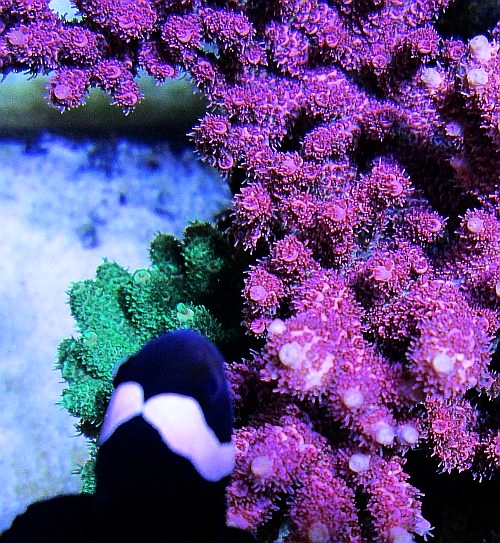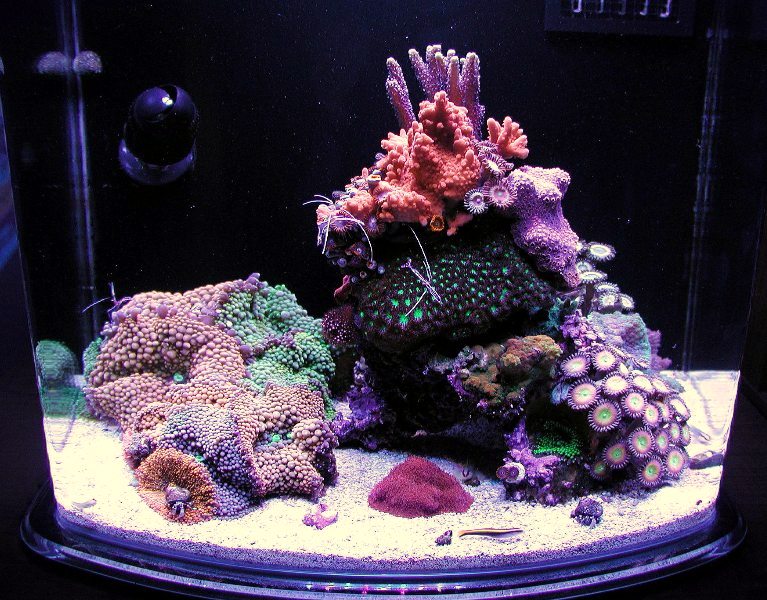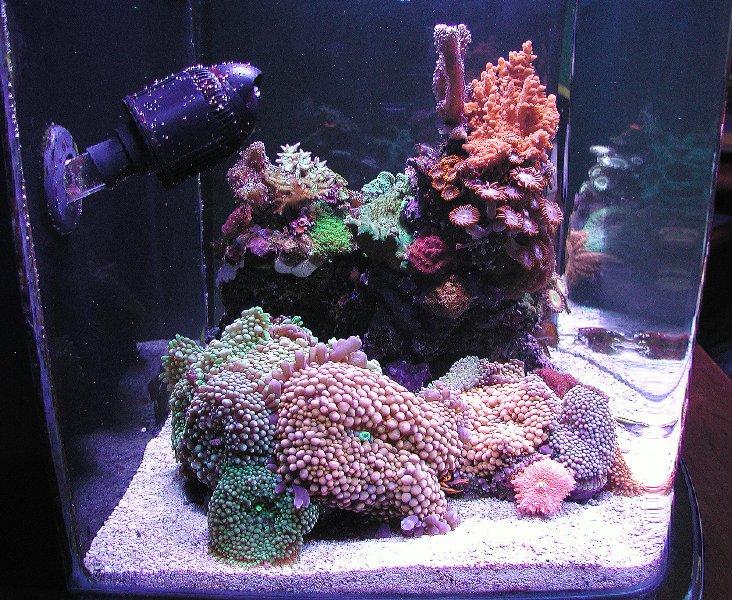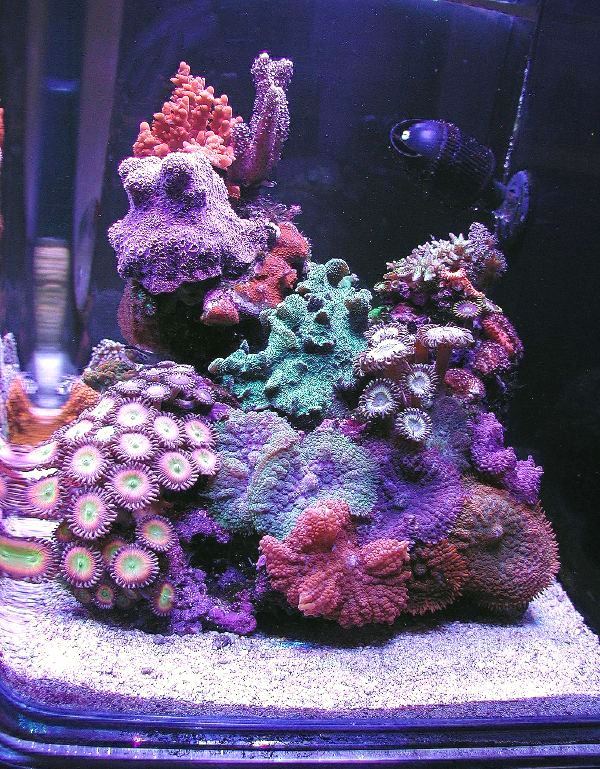- Joined
- Jan 27, 2017
- Messages
- 323
- Reaction score
- 270
Things to Consider Nano Reef Guide
Some of us reefers have been in this hobby for many years, and some just a few months. No matter what time-frame you have spent reefing at some point a nano-reef could possibly catch your eye, and I'm here to mitigate the intimidation factor that these bite-sized reef's put out, as well as map out a simple stable step-by-step process to maintain a stable marine life environment on a small scale. Nothing here will be high-tech and geared towards beginners but at the same time provide a good knowledge base for experienced reefers to escape the mindset that our hobby is too difficult, unenjoyable, or unstable on a small scale and possibly begin a nano-reef of your own!
Part I. Materials
Necessary materials
Now that we have gathered our materials-together it is time to design our compact reef-life support system. It is very important to always keep in mind that less is more when it comes to a nano-sized saltwater tank. Once you decide to hang a protein skimmer, calcium reactor, ATO, Apex system, header, filter, etc. things begin to get really cramped really fast, so it is important to think ahead on how you're going to get all the necessary materials needed for you to maintain a stable environment in such a small area. The most common way to complete this task is either by an overflow leading to a sump that can hide all your excess equipment. Having an external sump is a great way to add water-volume to your system as well which could in turn slow down your water parameters from taking hard left and right turns on you. Another great option is an AIO (All-In-One) Aquarium like a NUVO fusion that eliminates the need for plumbing, possible back-siphon, tank drilling and adds portability.
For you beginners completely intimidated by the cost, or designing and engineering that goes into running a high-tech filter system like a sump, I personally recommend using a nice big Hang on the Back filter that can hold multiple filter medias and can turn your tank volume over at least 2- 4 times per hour.
Part II. What is all these swinging water-parameters
There are a few things to consider when it comes to a nano-reef besides size, chemistry, and keeping a good maintenance schedule.
Lighting - Too much light could be deadly believe it or not, and too little light could also lead to its own plethora issues. I personally would not waste money on a super-high tech light system for a Nano reef of 10gallon or less. Reason being is that If I buy a powerful light I want to have a reason to crank that sucker up into its higher output ranges. On such a small tank I could either run expensive lights at 10% white and 30% blue or save money and go slightly less powerful and run them at 30% whites and 70% blues with room to still increase power if necessary. I have one goal when it comes to lighting on a nano reef and its to break out the old par-meter or, find the specs on your light and do some simple math to create the 3 most commonly referred to zones when speaking about what care a certain coral needs.
High light
Medium light
Low light
Waterflow - This is a fun subject as it's one of the more fine-tuned things that is just different on every reef tank. A nano tank enclosed with a powerhead has a lot more space to bounce off walls and create awkward patterns in current, making it difficult to really find and understand where your low flow areas and high flow areas are and how to adjust your powerhead. You really have to play this one like a game of pool, understand that however you aim your powerhead there will be current that not only reflects in the opposite angle but is also distorted and thrown around in random directions. Make sure you try out a system without a powerhead first and just use whatever return you have from your filtration system to move water around. On extremely small reefs you may be able to agitate the water surface with a small air-pump and air-line tubing without a stone. Always add more flow slowly as needed, never over-kill with something like a 500+ GPH pump on a tank thats only 20'' long and 10'' wide unless of course for whatever reason you have a coral that needs a tornado to move it around and keep it happy.

Part IV. Live stock.
Hopefully these explanations, and tips to keeping things in check on a nano style reef will help you over-come your fear of wanting to start one. Some in this community say you can't do it as a beginner, but I'm here telling you that you most certainly can if you are consistent, dedicated, and do a little extra research.
I want this to be an open guide so feel free to share any great tips you have to possibly add to this post so we can keep this guide ever-expanding, I really haven't seen any helpful guides for nano-aquariums that are active so I decided to make this one to hopefully kick-start one.
Part I. Materials
Necessary materials
- Aquarium of 5.5Gallons + (Anything smaller is considered a pico reef by me at least)
- Water quality test kits: Calcium, Magnesium, Alkalinity, Nitrite, Nitrate, Ammonia, Phosphate, and a Hydrometer
- Your salt-water mix
- Fish, corals, inverts etc.
- Live, Dry, Life Rock for nitrifying bacteria.
- Hang on back filter / Overflow sump system / Canister filter
- Heater
- Substrate
- Lighting
- Dry-erase markers
- Aquarium hood - HIGHLY RECOMMEND
- Refractometer
- Quarantine System
- Plenty of extra fresh/mixed water on hand
- Reef Crystal mix that contain trace elements needed for a thriving reef.
Now that we have gathered our materials-together it is time to design our compact reef-life support system. It is very important to always keep in mind that less is more when it comes to a nano-sized saltwater tank. Once you decide to hang a protein skimmer, calcium reactor, ATO, Apex system, header, filter, etc. things begin to get really cramped really fast, so it is important to think ahead on how you're going to get all the necessary materials needed for you to maintain a stable environment in such a small area. The most common way to complete this task is either by an overflow leading to a sump that can hide all your excess equipment. Having an external sump is a great way to add water-volume to your system as well which could in turn slow down your water parameters from taking hard left and right turns on you. Another great option is an AIO (All-In-One) Aquarium like a NUVO fusion that eliminates the need for plumbing, possible back-siphon, tank drilling and adds portability.
For you beginners completely intimidated by the cost, or designing and engineering that goes into running a high-tech filter system like a sump, I personally recommend using a nice big Hang on the Back filter that can hold multiple filter medias and can turn your tank volume over at least 2- 4 times per hour.
Part II. What is all these swinging water-parameters
The most important thing to understand is why it is recommended to start bigger rather than nano for a first time reef so we can mitigate these issues before they happen and open up nano as an option for new comers.
Salinity - Evaporation is an issue that all reefs face and as water evaporates salt does not. Pour a cup of crystals into one container and water into another, over several hours you will notice the level of water has dropped where the level of crystals remains the same in the cup. This is exactly what happens within your aquarium. Knowing this it's a simple matter of logic.
Less water + Reef crystal = High salinity
More water + Reef crystal = Low Salinity
This is where my dry-erase marker comes into play, I mark my tank up on each side on multiple spots with a dry-erase marker and pay close attention to water level. If my water goes below the line (As it naturally does everyday) I just pour some fresh water in until I'm back on top of it and now without even testing I know that my Salinity is the exact same as it was on that line originally. (It is not recommended to not test the salinity of your water)
You could use tape, dry-erase markers an Auto-top-off, or even that aquarium hood that I highly recommended earlier as the water evaporates and hits the hood it will drip back into your tank and hold the Salinity at a much more stable level.
Calcium, Alkalinity, Magnesium - These are the elements that will be used at varying rates by your corals. It is important to test for these levels in your aquarium as they are utilized in a fast manner. The good news is they will be replaced just as fast.
Picture your aquarium is like a bowl of cereal, your corals will eat the floating cereal pieces that represent (Ca, Alk, Mg). If there is no pieces of cereal for your corals to feed on, they will not grow and eventually die. Some corals can-not handle changes in the amount of cereal changing too fast in your aquarium if the amount changes too quickly.
The easiest way to mitigate this issue is by being a good reefer and absolutely sticking to a solid water-change plan using nutrient rich Reef Crystals. Using Crystals on a weekly basis could eliminate the need for any type of supplemental dosing of these trace elements since they are being replaced just as fast as they are being taken away. Keeping a consistent schedule with a consistently mixed batch of good heated to tank-temp aerated saltwater will also keep the water nice and stable for your more sensitive corals.
It should be noted that depending on volume of corals, as well as demand for nutrients, there is still a possibility of adding supplemental dosing of these elements.
Phosphates, and Nitrates - The way to manage these two parameters is limitless to the combinations of chemicals, maintenance schedule, and filtration methods. It's really up to you, but the biggest take away I want to get across is that you are at least managing these parameters constantly. I use a Phosphate/Silicate guard, and activated carbon (Chemi-pure Blue) to help with these parameters, and It works out nicely. But like I said it's totally up to you. If you have a sump you could add different reactors and equipment to maintain these parameters it's really all in how your wallet and plans are looking.
pH - pH could swing for multiple different reasons, my best suggestion for maintaining pH without swinging it way off the charts is: Try to stay away from chemicals to alter your pH on a nano aquarium like buffers or kalkwasser and try to find the reason why your pH is low in the first place. (Substrate, No fresh air in the room, etc...)
Conclusion - The biggest take-away from this section is the simple fact that if you are onto of your maintenance schedule, and are always testing and staying onto of your water parameters you will not run into anymore problems than you would not normally run into with a full-sized reef even as a beginner.
Part III. Things to consider.Salinity - Evaporation is an issue that all reefs face and as water evaporates salt does not. Pour a cup of crystals into one container and water into another, over several hours you will notice the level of water has dropped where the level of crystals remains the same in the cup. This is exactly what happens within your aquarium. Knowing this it's a simple matter of logic.
Less water + Reef crystal = High salinity
More water + Reef crystal = Low Salinity
This is where my dry-erase marker comes into play, I mark my tank up on each side on multiple spots with a dry-erase marker and pay close attention to water level. If my water goes below the line (As it naturally does everyday) I just pour some fresh water in until I'm back on top of it and now without even testing I know that my Salinity is the exact same as it was on that line originally. (It is not recommended to not test the salinity of your water)
You could use tape, dry-erase markers an Auto-top-off, or even that aquarium hood that I highly recommended earlier as the water evaporates and hits the hood it will drip back into your tank and hold the Salinity at a much more stable level.
Calcium, Alkalinity, Magnesium - These are the elements that will be used at varying rates by your corals. It is important to test for these levels in your aquarium as they are utilized in a fast manner. The good news is they will be replaced just as fast.
Picture your aquarium is like a bowl of cereal, your corals will eat the floating cereal pieces that represent (Ca, Alk, Mg). If there is no pieces of cereal for your corals to feed on, they will not grow and eventually die. Some corals can-not handle changes in the amount of cereal changing too fast in your aquarium if the amount changes too quickly.
The easiest way to mitigate this issue is by being a good reefer and absolutely sticking to a solid water-change plan using nutrient rich Reef Crystals. Using Crystals on a weekly basis could eliminate the need for any type of supplemental dosing of these trace elements since they are being replaced just as fast as they are being taken away. Keeping a consistent schedule with a consistently mixed batch of good heated to tank-temp aerated saltwater will also keep the water nice and stable for your more sensitive corals.
It should be noted that depending on volume of corals, as well as demand for nutrients, there is still a possibility of adding supplemental dosing of these elements.
Phosphates, and Nitrates - The way to manage these two parameters is limitless to the combinations of chemicals, maintenance schedule, and filtration methods. It's really up to you, but the biggest take away I want to get across is that you are at least managing these parameters constantly. I use a Phosphate/Silicate guard, and activated carbon (Chemi-pure Blue) to help with these parameters, and It works out nicely. But like I said it's totally up to you. If you have a sump you could add different reactors and equipment to maintain these parameters it's really all in how your wallet and plans are looking.
pH - pH could swing for multiple different reasons, my best suggestion for maintaining pH without swinging it way off the charts is: Try to stay away from chemicals to alter your pH on a nano aquarium like buffers or kalkwasser and try to find the reason why your pH is low in the first place. (Substrate, No fresh air in the room, etc...)
Conclusion - The biggest take-away from this section is the simple fact that if you are onto of your maintenance schedule, and are always testing and staying onto of your water parameters you will not run into anymore problems than you would not normally run into with a full-sized reef even as a beginner.
There are a few things to consider when it comes to a nano-reef besides size, chemistry, and keeping a good maintenance schedule.
Lighting - Too much light could be deadly believe it or not, and too little light could also lead to its own plethora issues. I personally would not waste money on a super-high tech light system for a Nano reef of 10gallon or less. Reason being is that If I buy a powerful light I want to have a reason to crank that sucker up into its higher output ranges. On such a small tank I could either run expensive lights at 10% white and 30% blue or save money and go slightly less powerful and run them at 30% whites and 70% blues with room to still increase power if necessary. I have one goal when it comes to lighting on a nano reef and its to break out the old par-meter or, find the specs on your light and do some simple math to create the 3 most commonly referred to zones when speaking about what care a certain coral needs.
High light
Medium light
Low light
Waterflow - This is a fun subject as it's one of the more fine-tuned things that is just different on every reef tank. A nano tank enclosed with a powerhead has a lot more space to bounce off walls and create awkward patterns in current, making it difficult to really find and understand where your low flow areas and high flow areas are and how to adjust your powerhead. You really have to play this one like a game of pool, understand that however you aim your powerhead there will be current that not only reflects in the opposite angle but is also distorted and thrown around in random directions. Make sure you try out a system without a powerhead first and just use whatever return you have from your filtration system to move water around. On extremely small reefs you may be able to agitate the water surface with a small air-pump and air-line tubing without a stone. Always add more flow slowly as needed, never over-kill with something like a 500+ GPH pump on a tank thats only 20'' long and 10'' wide unless of course for whatever reason you have a coral that needs a tornado to move it around and keep it happy.
Clean up crews (CUC's) are often the most misunderstood aspect of adding life to your reef system. Theres a few things I would like to say before moving further:
A CUC is NOT the solution to an algae problem, they are also not to be added to your system in a face paced manner, and NO you do not need 1 hermit crab and 1 snail per gallon of aquarium you have.
Now thats out of the way, it's important to understand that by adding to many CUC members you will eventually notice starvation, and then death which will pollute your water. Not only is this a big deal in a reef tank but this is a HUGE DEAL in a nano-reef tank as we discussed earlier your water parameters will not absorb the ammonia, and other crud being let out from basically a rotten-food vacuum like a full sized tank would, and it will spike fast. I keep 1 Hermit and 1 Nassarius snail in my 10 Gallon reef, thats literally it. It's my job to keep my tank clean not theirs, they are just there to help and never forget that. I also added them just as slowly as a fish, I keep a rule of 1 living organism that will produce waste at a time. (Unless its a pair of bonded clowns or something).
Fish - It's really up to you and what your beliefs are when it comes to adding fish into an aquarium as far as if a clown fish will only be happy in a 30gallon or a 10gallon set-up. But one of the most important things to consider is space for your guys who need it the most. Cramming aggressive fish in a small area with no where to claim as their own could lead to a prison-yard style fight to the death. So just make sure you are still considering the fact that if they will live and thrive in a nano, if the fish is still in the correct habitat for your nano.
A CUC is NOT the solution to an algae problem, they are also not to be added to your system in a face paced manner, and NO you do not need 1 hermit crab and 1 snail per gallon of aquarium you have.
Now thats out of the way, it's important to understand that by adding to many CUC members you will eventually notice starvation, and then death which will pollute your water. Not only is this a big deal in a reef tank but this is a HUGE DEAL in a nano-reef tank as we discussed earlier your water parameters will not absorb the ammonia, and other crud being let out from basically a rotten-food vacuum like a full sized tank would, and it will spike fast. I keep 1 Hermit and 1 Nassarius snail in my 10 Gallon reef, thats literally it. It's my job to keep my tank clean not theirs, they are just there to help and never forget that. I also added them just as slowly as a fish, I keep a rule of 1 living organism that will produce waste at a time. (Unless its a pair of bonded clowns or something).
Fish - It's really up to you and what your beliefs are when it comes to adding fish into an aquarium as far as if a clown fish will only be happy in a 30gallon or a 10gallon set-up. But one of the most important things to consider is space for your guys who need it the most. Cramming aggressive fish in a small area with no where to claim as their own could lead to a prison-yard style fight to the death. So just make sure you are still considering the fact that if they will live and thrive in a nano, if the fish is still in the correct habitat for your nano.
_______________
Hopefully these explanations, and tips to keeping things in check on a nano style reef will help you over-come your fear of wanting to start one. Some in this community say you can't do it as a beginner, but I'm here telling you that you most certainly can if you are consistent, dedicated, and do a little extra research.
I want this to be an open guide so feel free to share any great tips you have to possibly add to this post so we can keep this guide ever-expanding, I really haven't seen any helpful guides for nano-aquariums that are active so I decided to make this one to hopefully kick-start one.
Last edited by a moderator:






